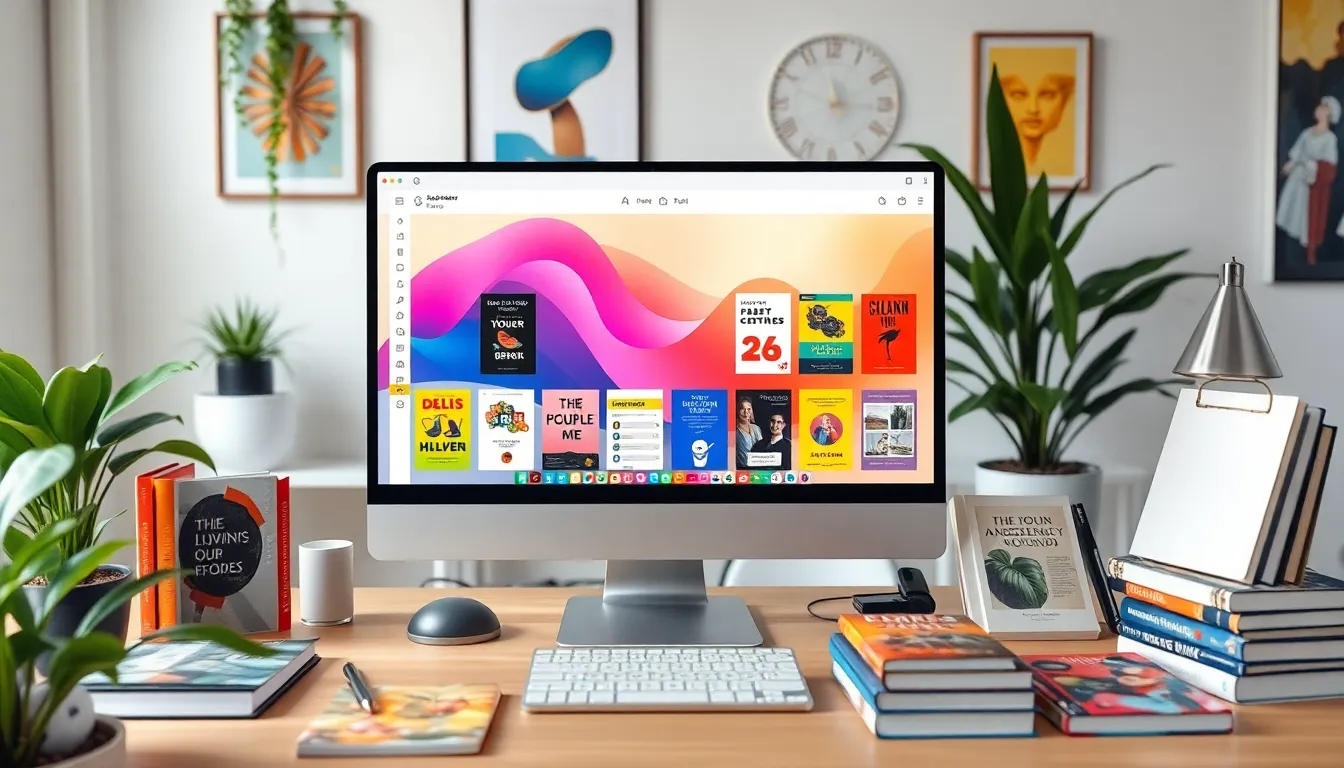Table of Contents
ToggleIn a world where first impressions matter more than ever, a book cover can make or break a reader’s interest. Enter AI book covers—the secret weapon authors didn’t know they needed. Imagine having a design team that works 24/7, never complains about coffee breaks, and can whip up stunning visuals faster than you can say “best-seller.”
Overview of AI Book Covers
AI-generated book covers represent a revolutionary advancement in design. Authors utilize these innovative tools to create visually striking covers that grab reader attention.
What is an AI Book Cover?
An AI book cover refers to a book cover designed using artificial intelligence technology. This technology processes vast amounts of visual data to generate unique designs quickly. By leveraging machine learning algorithms, these tools analyze successful book covers and produce images tailored to specific genres and themes. Individuals can customize elements such as color schemes, typography, and graphic styles based on personal preferences or market trends. The result is an engaging visual representation that enhances a book’s appeal.
Benefits of Using AI for Book Covers
Efficiency characterizes AI book cover creation, enabling authors to produce professional-quality designs in minutes. Cost-effectiveness arises as expenses associated with hiring a professional designer decrease significantly. Various styles emerge from algorithms, allowing authors to explore unique concepts that may not have been considered otherwise. AI also provides valuable insights based on market trends, helping authors choose designs that resonate with their target audience. The customization options ensure that each cover reflects the author’s vision while maintaining high aesthetic standards.
Popular Tools for AI Book Cover Creation

Various tools have emerged in the realm of AI book cover creation, each offering unique features tailored to authors’ needs.
Platform Comparisons
Several platforms stand out for AI book cover design. Canva provides an intuitive drag-and-drop interface, allowing users to customize pre-made templates. BookCover.ai specializes in genre-specific designs and uses AI to suggest layouts based on existing popular works. Fotor offers advanced editing features alongside its AI generator, making it suitable for users seeking more control. Adobe Spark, while established, has incorporated AI elements to enhance creative freedom. Authors can evaluate pricing, customization options, and output quality to determine the best fit for their projects.
Key Features to Look For
When selecting an AI book cover tool, certain features become essential. A robust customization toolkit enables authors to adjust colors, typography, and images easily. The inclusion of genre-based templates helps streamline the design process. Speed in generating designs provides efficiency, while user-friendly interfaces simplify navigation. Additionally, tools that incorporate market trend analysis can offer valuable insights, helping authors align their designs with reader preferences. Finally, consider the quality of AI-generated image outputs, ensuring they meet professional standards.
Design Elements of AI Book Covers
Design elements significantly influence the effectiveness of AI-generated book covers. These components shape the first impression readers have of a book, thereby affecting their purchasing decisions.
Color Schemes and Typography
Color schemes play a vital role in establishing a book’s mood. Shades like bold reds or soft blues indicate different genres, capturing potential readers’ emotions. Authors can experiment with contrasting colors for a striking visual impact. Typography contributes to this effect by reflecting a book’s theme. Fonts ranging from elegant serif styles to modern sans-serif designs can evoke various feelings. It’s crucial for authors to choose readable typefaces that align with their genre and target audience, ensuring clarity and engagement.
Imagery and Graphics
Imagery carries the weight of storytelling visually. AI tools generate unique images that convey the essence of a book’s narrative. Graphic elements, such as illustrations or patterns, can support the central theme, drawing in viewers. An enticing visual can create curiosity and prompt potential readers to explore further. Custom graphics tailored to genre-specific ideas enhance a book cover’s appeal. Selecting striking imagery and cohesive graphics creates an inviting aesthetic that resonates with readers and communicates the core message of the book effectively.
Case Studies of Successful AI Book Covers
Successful implementations of AI-generated book covers illustrate the technology’s potential in transforming visual marketing for authors. Notable examples demonstrate how these covers attract attention and increase reader engagement across genres.
Author Perspectives
Authors report significant satisfaction with AI book cover tools. They appreciate the speed and customization options these platforms provide. One author highlighted that experimenting with different designs allowed for a unique expression of their book’s theme. Another noted the ability to quickly modify elements based on feedback, which enhanced the final product’s alignment with their vision. Overall, many authors express that AI tools enable them to connect with their audience effectively by translating their creative ideas into striking visuals.
Sales Performance Analysis
Sales data indicates a marked improvement in books featuring AI-generated covers. Notably, a study revealed that titles with such covers experienced an increase in sales of up to 30%. These visually compelling designs appeal to readers, driving higher click-through rates on online platforms. Additionally, genre-specific designs contribute to better market performance, as they resonate closely with target audiences. An analysis of several titles showed that AI-generated covers often outperform traditional ones in both visibility and sales metrics. This correlation highlights the growing significance of effective cover design in the competitive book market.
Future Trends in AI Book Cover Design
Emerging trends in AI book cover design indicate a significant shift toward personalization and interactivity. Tools are evolving to incorporate user preferences, allowing authors to tailor designs that resonate with target audiences effectively. Data-driven insights from readers’ behaviors further enhance design relevance, focusing on elements like color psychology and imagery trends.
Designers are adopting augmented reality (AR) elements in covers, creating immersive experiences for readers. AR can make book covers come alive through smartphones, drawing audiences into a deeper interaction beyond the physical page. Such innovation not only attracts attention but also enhances reader engagement and retention.
Additionally, integration of generative adversarial networks (GANs) refines the creation process, producing high-quality images and graphics in real time. This leads to unique cover designs that stand out in saturated markets. Increased competition drives platforms to leverage advanced AI capabilities, ensuring authors have access to cutting-edge tools.
The push for sustainability influences design choices as well. Eco-friendly concepts are becoming a focal point, aligning with the growing consumer demand for environmentally conscious publishing. AI’s efficiency in generating digital designs reduces the need for physical resources, promoting sustainable practices.
Collaborative platforms are expanding, allowing authors to co-create with AI. These platforms facilitate seamless communication between authors and AI, fostering creativity while maintaining the author’s unique vision. Such collaboration paves the way for innovative designs that not only captivate but also tell compelling stories.
Investment in AI technology for book design reflects industry confidence in its transformative potential. Increased research and development lead to continued improvements in design tools, further enhancing user experience and output quality. The future of AI-generated book covers clearly charts a promising course for authors seeking to elevate their work visually.
AI-generated book covers are changing the landscape of visual storytelling. They offer authors an efficient and cost-effective way to create captivating designs that resonate with readers. With tools like Canva and BookCover.ai, authors can easily customize their covers to reflect their unique vision and market trends.
As the technology evolves, the potential for personalization and interactivity in book cover design will only grow. Authors can look forward to innovative features that enhance reader engagement and strengthen their connection with audiences. Embracing AI in cover design not only elevates a book’s visual appeal but also positions authors for greater success in a competitive market.





